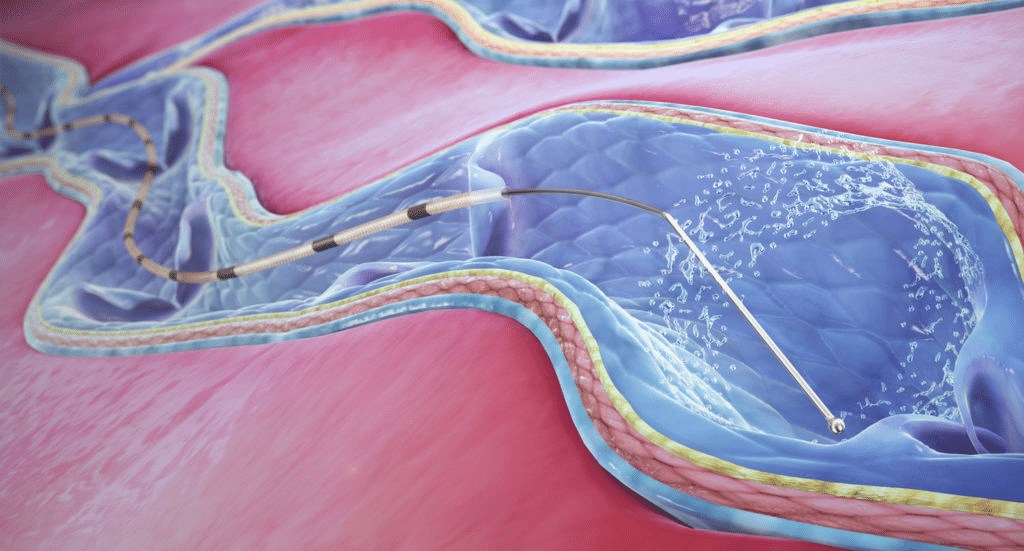Varicose veins are twisted, enlarged veins that can appear anywhere on the body, though they’re most commonly found on the legs. The condition, like spider…
What is ClariVein, and What Are Its Advantages?

Varicose veins are twisted, enlarged veins that can appear anywhere on the body, though they’re most commonly found on the legs. The condition, like spider veins, is caused by excess pressure within the veins. When the valves within your veins weaken or suffer damage, blood can collect in the veins, causing them to grow bigger.
In most instances, varicose veins aren’t a serious medical concern but can cause you to feel uncomfortable. Depending on how noticeable they are, you may consider cosmetic options to reduce the appearance of varicose veins. ClariVein is a newer varicose vein treatment designed to permanently rid patients of the issue.
What Is ClariVein?
ClariVein, also known as mechanochemical ablation (MOCA), involves inserting a rotating catheter inside the abnormal vein using an ultrasound guide. The rotation of the catheter, in conjunction with a sclerosant medicine, seals off the vein.
ClariVein is more effective in this stage because the catheter damages the walls of the varicose veins, preparing them for the sclerosant. The procedure doesn’t require anesthesia along the entire vein. It takes about an hour for physicians to perform. Doctors typically perform the procedure within their office. There is little need for aftercare for vein ablation with Clarivein.
Older methods of dealing with varicose veins included stripping, or removing, the abnormal vein. However, that was a major surgery that often led to the vein growing back. Using ClariVein helps prevent the regrowth of veins in the future.
How Does ClariVein Compare to Other Varicose Vein Treatments?
Let’s look at some other standard methods of dealing with varicose veins.
Endovenous Laser Ablation (EVLA)
Endovenous laser ablation, known under the brand name VenaCure EVLT, is similar to ClariVein. It involves an ultrasound used to visualize the vein to help guide the insertion of a catheter into the abnormal vein. Instead of a sclerosant, the physician introduces a laser fiber through the catheter. As the doctor gradually removes the catheter, they send heat through the laser along the length of the vein. That causes the vein to close up and shrink over time.
Unlike ClariVein, the catheter does not rotate, so there’s no preliminary damage done to the varicose vein walls. In addition, the doctor applies a local anesthetic to numb the area where they will insert the catheter and anesthetizes the vein designated for treatment.
Endovenous Radiofrequency Ablation (RFA)
Like ClariVein and EVLA, RFA relies on an ultrasound to visualize the varicose vein and guide the doctor. RFA, known under brand names like ClosureFast and Venclose, is often performed on an outpatient basis.
The physician makes a small incision in the target area and inserts an electrode or fiber. The doctor then inserts anesthesia around the vein, causing it to collapse. That anesthesia also acts as insulation for the heat/energy generated through the fiber or electrode that causes the varicose vein to close. The vein shrinks in size over time.
Microfoam Injection
Microfoam injections, brand name Varithena, involve locating a varicose vein candidate via ultrasound, then injecting a sclerosant with a texture similar to shaving cream into a vein. That foam displaces the blood within the varicose vein before turning back into a liquid after a few minutes.
Cyanoacrylate
Cyanoacrylate glue, or VenaSeal, has long been used for treating varicose veins. The treatment consists of cyanoacrylate glue with a delivery system that includes a glue gun and a catheter.
The doctor locates an injection site in a varicose vein using ultrasound. Next, the physician applies a topical anesthetic and inserts the glue inside the vein through the catheter. The doctor makes continuous injections of glue along the entire length of the vein. They review the results via ultrasound to confirm the success of the procedure.
What Are the Benefits and Drawbacks of ClariVein?
There are a lot of options available for treating varicose veins. So why would you want to opt for ClariVein over the other solutions? The most significant benefit of using ClariVein is that you don’t have to deal with a lot of needle sticks of numbing medication the way you would with Endovenous Laser or Radiofrequency Ablation. In addition, recovery time is typically shorter because the doctor isn’t sending heat or energy through the vein, resulting in some pain from procedures like EVLA or RFA. The need for aftercare for vein ablation is minimized.
According to a trial performed comparing ClariVein to RFA, patients who had Clarivein experienced up to 97% effectiveness in having veins fully closed. In addition, the patients who received MOCA treatment experienced a faster recovery and less discomfort. Even though patients may have an easier time recovering from ClariVein versus other varicose vein treatments, you may still experience some bruising or swelling for a week or so afterward. In addition, there may be some soreness around the site of the injection. There’s also some minimal potential for developing a blood clot within the varicose veins.
The biggest drawback to ClariVein is that most insurance companies won’t cover the treatment. They often will pay for more conventional treatments like RFA and Microfoam injections.
Get Help Finding the Right Varicose Vein Treatment
With so many options available for treating varicose veins, it can be difficult to go about locating a specialist who can provide you with the right guidance. Use the My Vein Treatment Locator tool to find a physician in your area who can assist you with treating your varicose veins.






Responses